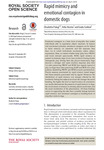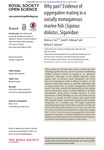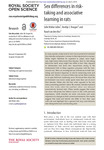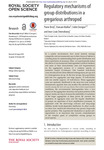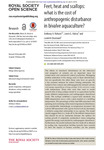Search
Now showing items 121-130 of 144
Rapid mimicry and emotional contagion in domestic dogs
(2015)
Emotional contagion is a basic form of empathy that makes individuals able to experience others’ emotions. In human and non-human primates, emotional contagion can be linked to facial mimicry, an automatic and fast response ...
Why pair? Evidence of aggregative mating in a socially monogamous marine fish
(2015)
Many species live in stable pairs, usually to breed and raise offspring together, but this cannot be assumed. Establishing whether pairing is based on mating, or an alternative cooperative advantage, can be difficult, ...
Parental investment in child health in sub-Saharan Africa: a cross-national study of health-seeking behaviour
(2016)
Parents face trade-offs between investing in child health and other fitness enhancing activities. In humans, parental investment theory has mostly been examined through the analysis of differential child outcomes, with ...
Sex differences in risk-taking and associative learning in rats
(2015)
In many species, males tend to have lower parental investment than females and greater variance in their reproductive success. Males might therefore be expected to adopt more high-risk, high-return behaviours than females. ...
Regulatory mechanisms of group distributions in a gregarious arthropod
(2015)
In a patchy environment, how social animals manage conspecific and environmental cues in their choice of habitat is a leading issue for understanding their spatial distribution and their exploitation of resources. Here, ...
X-ray microtomography provides first data about the feeding behaviour of an endangered lizard, the Montserrat galliwasp
(2015)
Reporting the diet of recently extinct or very rare taxa, only known by a few museum specimens, is challenging. This study uses X-ray microtomography, a non-destructive investigation method, to obtain the first data about ...
Aremigratory behaviours of bats socially transmitted?
(2016)
To migrate, animals rely on endogenous, genetically inherited programmes, or socially transmitted information about routes and behaviours, or a combination of the two. In long-lived animals with extended parental care, as ...
Assessing recognition memory using confidence ratings and response times
(2016)
Classification of stimuli into categories (such as ‘old’ and ‘new’ in tests of recognition memory or ‘present’ versus ‘absent’ in signal detection tasks) requires the mapping of internal signals to discrete responses. ...
Feet, heat and scallops
(2016)
The effects of unnatural disturbances on the behaviour and energetics of animals are an important issue for conservation and commercial animal production. Biologging enables estimation of the energy costs of these disturbances, ...
Trophic niche divergence among colour morphs that exhibit alternative mating tactics
(2016)
Discrete colour morphs associated with alternative mating tactics are assumed to be ecologically equivalent. Yet suites of behaviours linked with reproduction can also favour habitat segregation and exploitation of different ...

